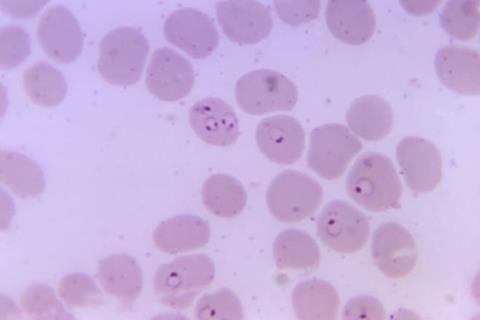A novel testing platform under development by researchers at the Yale School of Public Health (YSPH) and CytoAstra, LLC could provide a new noninvasive test for malaria that doesn’t require a blood sample.

The platform technology, known as cytophone, detects malaria infection in blood cells using lasers and ultrasound. Researchers developing the platform believe it could provide more sensitive and reliable testing results compared to the more traditional blood tests for malaria, which require a blood sample and tend to detect malaria only at higher parasite burdens, hindering effective detection and treatment.
Improved prototypes
The research team recently received a $500,000 grant from the Bill & Melinda Gates Foundation that will allow them to build two improved prototypes of the testing platform and to do extensive field testing in Burkina Faso, where malaria is endemic, said Dr. Sunil Parikh, an associate professor of epidemiology (microbial diseases) at YSPH and of infectious diseases at the Yale School of Medicine. Parikh is a co-principal investigator on the project.
In 2021 (the most recent year for which data is available), nearly half of the world’s population lived in an area where malaria is endemic, according to the World Health Organization (WHO). There were an estimated 247 million malaria cases that year — an increase of 2 million compared with 2020 — and 619,000 deaths, according to the WHO. Young children, pregnant women, and nonimmune travelers are the most vulnerable to severe infection.
Parikh’s co-principal investigator is Vladimir Zharov, director of the Arkansas Nanomedicine Center at the University of Arkansas for Medical Sciences and co-founder of CytoAstra, a company advancing cytophone research. CytoAstra is a sub-award recipient of the foundation grant.
Zharov, a pioneer in noninvasive technologies for medical applications, has previously applied cytophone technology for the noninvasive detection ofcirculating melanoma cells. Realizing the platform’s potential application for human malaria, Zharov teamed up with Parikh, whose research centers on malaria interventions in Africa, to develop a portable cytophone prototype that could detect malaria infection in people living in endemic settings.
Cytophone technology
For malaria, the cytophone technology uses lasers at specific wavelengths focused on superficial blood vessels. When the parasites that cause malaria infection enter red blood cells, they use the haemoglobin inside those cells to liberate amino acids.
A byproduct of this process is the release of hemozoin, a compound containing iron. When hit by a laser, hemozoin absorbs more of the laser’s energy than haemoglobin, meaning cells infected with malaria parasites absorb more than noninfected cells. This absorbed energy is transformed into heat, and the heat expansion generates acoustic waves.
The cytophone technology detects these waves using a small ultrasound transducer placed on the skin. After software analysis, peaks in the detected acoustic waves can identify malaria infection.
Portable device
In a prior study published in Scientific Reports, Zharov and Parikh showed their device could identify infection in mice using a rodent species of malaria parasite and in blood using a human malaria parasite.
The Zharov team then developed a portable version of the device and the researchers jointly completed a human proof-of-concept study in malaria-infected adults in Cameroon with Professor Yap Boum, currently executive director of the Pasteur Institute of Bangui, and a long-standing collaborator of the Parikh lab. The results were promising and are under review for journal publication, Parikh said.
Parikh praised the multidisciplinary collaborative effort with Zharov and their Cameroonian colleagues in advancing the technology. Working together “opened doors that we would never have been able to open separately,” he said.
The cytophone technology could represent a big improvement in diagnosing, treating, and understanding malaria, said Parikh.
Current methods
Malaria is currently diagnosed by two methods. In light microscopy, long the standard for diagnosis, blood is smeared on a slide, stained, and studied under a microscope. But because this requires resources and expertise, it is being replaced in many areas by rapid antigen blood tests. These are designed to react to the presence of a specific antigen, or protein found on the surface of a pathogen, in a sample.
A problem with both methods is that they aren’t very sensitive. “You can have a very large parasite load with both microscopy and rapid diagnostic tests before you have a positive test,” Parikh said.
Because the cytophone technology can potentially scan a much larger volume of blood, it should be far more sensitive than current tests, Parikh said. The technology also could address an emerging problem with some antigen tests, he added.
Antigen test challenges
In Africa, the most common antigen tests search for an antigen on Plasmodium falciparum, the locally dominant of the five species of protozoa that cause human malaria, and the most dangerous. But researchers are finding more and more samples of the parasite with deletions of that antigen. In some places, most of the parasites no longer express that antigen, Parikh said.
Since cytophone uses hemozoin, which all species of malaria parasites produce as part of their life cycle, as a marker, it would avoid this problem, Parikh said.
“We don’t think that there’s ever a situation where hemozoin wouldn’t be present over the life cycle of the parasite,” he said.
In addition to diagnosis problems, a challenge plaguing malaria treatment in the long term is that the parasites become resistant to medications. Since the technology focuses on hemozoin, it could be useful to researchers trying to develop and study new antimalarial drugs that target this pathway in humans, noninvasively, Parikh said. “I think that would be a really exciting avenue for this device.”







No comments yet